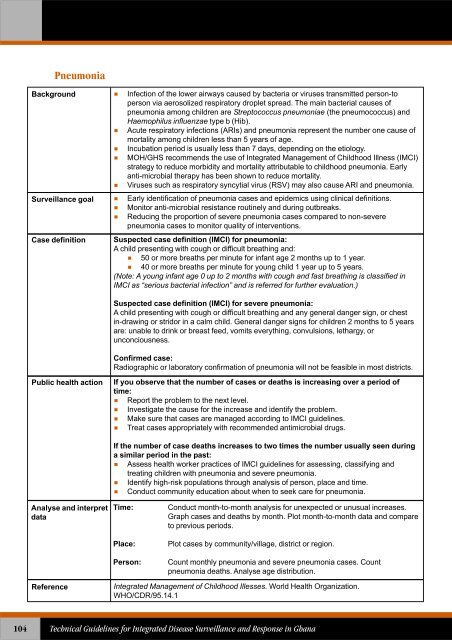Technical Guidelines for Integrated Disease Surveillance ... - PHRplus
Technical Guidelines for Integrated Disease Surveillance ... - PHRplus
Technical Guidelines for Integrated Disease Surveillance ... - PHRplus
Create successful ePaper yourself
Turn your PDF publications into a flip-book with our unique Google optimized e-Paper software.
PneumoniaBackground Infection of the lower airways caused by bacteria or viruses transmitted person-toperson via aerosolized respiratory droplet spread. The main bacterial causes ofpneumonia among children are Streptococcus pneumoniae (the pneumococcus) andHaemophilus influenzae type b (Hib). Acute respiratory infections (ARIs) and pneumonia represent the number one cause ofmortality among children less than 5 years of age.Incubation period is usually less than 7 days, depending on the etiology.MOH/GHS recommends the use of <strong>Integrated</strong> Management of Childhood Illness (IMCI)strategy to reduce morbidity and mortality attributable to childhood pneumonia. Earlyanti-microbial therapy has been shown to reduce mortality.Viruses such as respiratory syncytial virus (RSV) may also cause ARI and pneumonia.<strong>Surveillance</strong> goal Early identification of pneumonia cases and epidemics using clinical definitions. Monitor anti-microbial resistance routinely and during outbreaks. Reducing the proportion of severe pneumonia cases compared to non-severepneumonia cases to monitor quality of interventions.Case definitionSuspected case definition (IMCI) <strong>for</strong> pneumonia:A child presenting with cough or difficult breathing and: 50 or more breaths per minute <strong>for</strong> infant age 2 months up to 1 year. 40 or more breaths per minute <strong>for</strong> young child 1 year up to 5 years.(Note: A young infant age 0 up to 2 months with cough and fast breathing is classified inIMCI as “serious bacterial infection” and is referred <strong>for</strong> further evaluation.)Suspected case definition (IMCI) <strong>for</strong> severe pneumonia:A child presenting with cough or difficult breathing and any general danger sign, or chestin-drawing or stridor in a calm child. General danger signs <strong>for</strong> children 2 months to 5 yearsare: unable to drink or breast feed, vomits everything, convulsions, lethargy, orunconciousness.Confirmed case:Radiographic or laboratory confirmation of pneumonia will not be feasible in most districts.Public health actionAnalyse and interpretdataIf you observe that the number of cases or deaths is increasing over a period oftime: Report the problem to the next level. Investigate the cause <strong>for</strong> the increase and identify the problem. Make sure that cases are managed according to IMCI guidelines.Treat cases appropriately with recommended antimicrobial drugs.If the number of case deaths increases to two times the number usually seen duringa similar period in the past: Assess health worker practices of IMCI guidelines <strong>for</strong> assessing, classifying andtreating children with pneumonia and severe pneumonia. Identify high-risk populations through analysis of person, place and time.Conduct community education about when to seek care <strong>for</strong> pneumonia.Time:Conduct month-to-month analysis <strong>for</strong> unexpected or unusual increases.Graph cases and deaths by month. Plot month-to-month data and compareto previous periods.Place:Person:Plot cases by community/village, district or region.Count monthly pneumonia and severe pneumonia cases. Countpneumonia deaths. Analyse age distribution.Reference<strong>Integrated</strong> Management of Childhood Illesses. World Health Organization.WHO/CDR/95.14.1104<strong>Technical</strong> <strong>Guidelines</strong> <strong>for</strong> <strong>Integrated</strong> <strong>Disease</strong> <strong>Surveillance</strong> and Response in Ghana















